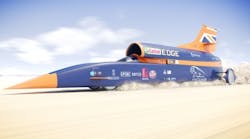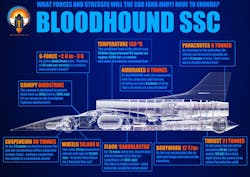Richard Noble’s Bloodhound project announced that its Bloodhound supersonic car (SSC) will attempt to break the land-speed record in October 2017, which puts the pressure on its competitors. The record speed is currently held by Andy Greene, who drove the organization’s Thrust2 vehicle at a peak speed of 1019 km/h. Its predecessor, driven by Noble, was the first man-operated land vehicle to break the sound barrier, surpassing 1235.5 km/hour. Britain has held the land-speed record for more than 30 years, and plans to break 1,000 mph, or 1,610 km/h, to reach 1.4 Mach speeds.
In addition to the prospects of breaking records, the Bloodhound project inspires STEM education about supersonic and F1 vehicles. With over 6,000 schools in the UK that use Bloodhound technical content, the project inspired a range of competitions (including the model rocket car competition) and workshops (like building k’Nex air rocket cars) and is followed in more than 220 countries. Bloodhoundblast.com offers free lesson plans and 10,000 learning resources to students around the world, delivering learning tools on topics ranging from aerodynamics to drag and kinetic physics.
Bloodhound will meet land-speed record regulations set by the Fédération Internationale de l'Automobile (FIA). Andy Greene will once again take the wheel, with the event taking place in the Hakskeepnan desert in South Africa. Rocks have already been cleared from the track to ensure that the vehicle can reach optimum speeds.
Before attempting to break the record in October, Bluehound will travel under its own power in a slow-speed shakedown test in June 2017. It will reach speeds as high as 98 meters/s, or 800 miles per hour.
The Turnaround Challenge
One huge hurdle for Bloodhound must overcome to meet FIA regulations is the vehicle’s ability to turn around and come back in the other direction after rolling to a complete stop. The requirement, which went into effect in 1914, states that the vehicle should complete the round trip in a single hour. This will require fast action from the Bloodhound team to refuel the vehicle, replace “burnt-out” parts, and perform necessary servicing.
Services to Bloodhound during this timeframe will include wheel replacement, refueling of both 300-400 kg of jet fuel and a ton of High-Test Peroxide, spark-plug replacement, cooling-water and rocket-tube replacement, and repacking the drag chute.
Bloodhound must also solely be propelled by engines mounted on its body, with no transmission to the wheels. The car uses both a jet engine and a rocket engine.
The Rocket/Jet Propulsion System
Though original plans were to propel Bloodhound using only rocket power, the team decided they needed to include a propulsion system that could more easily be controlled, so they included a jet engine in the design.
Bloodhound will be propelled using both rocket and jet
power. They eventually chose the EUROJET EJ200 jet engine, an internal combustion gas turbine. It functions by sucking in air, which is then compressed in the compressor. Fuel will then be added and burned so as to expand the air and expel exhaust from the nozzle to produce thrust. Energy from the combustion will also be used to drive the compressor.
The car’s design is like a hybrid aircraft and racing car. Its front section is a fiber-carbon monocoque (i.e., skeleton) and its back section comprises a metal framework and panels like an aircraft. At the formal demonstrations, it will measure 13.5 meters in length and weigh about 7.5 tons.
Reinventing the Wheel
Because the car is running on the ground, its wheels required a special design so that they could spin at the high speeds that are accompanied with sonic booms and turbulence as they break the sound barrier. They rotate up to 10,200 rpm or 17 times per second, which is four times faster than on a Formula 1 car, and they are about three times bigger! (1) Such fast spinning generates radial g. The forge wheel consists of forged 7037 titanium. The video below describes some of the challenges and eventual solutions in designing the Bloodhound wheels.
Among other episodes in the Cisco Bloodhound TV series is “How do you stop a 1,000 mph car,” which describes the braking system. Follow the project on Bloodhound SSC’s YouTube channel, Twitter, and Facebook. The site also offers a range of infographics about the car and the race.


